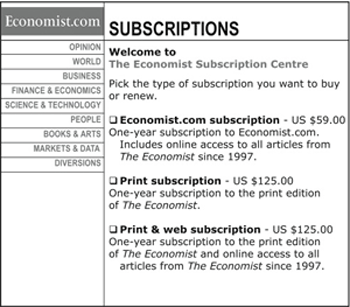The well-known story of how the Economist magazine’s clever pricing led to a dramatic increase in premium subscriptions – an example of the asymmetric dominance or decoy effect1 – is probably incorrect. And it doesn’t really matter.

Two separate journal articles published this year have failed to replicate this classic finding after multiple attempts with thousands of participants (Frederick, Lee, & Baskin, 2014; Yang & Lynn, 2014). These studies have helped clarify that the asymmetric dominance effect generally only occurs with salient, numerically-defined attributes in which the dominance relationship is readily encoded. In the Economist example, the choices are defined by a jumble of words and numbers. It is much easier to compare $59 to $125 than “Economist.com subscription” to “Print & web subscription.” Combining these two dimensions mutes the effect.
Why did the example “work” ten years ago and why is it “not working” today? Nobody knows. Perhaps the concept of a print magazine is simply less relevant in 2014. Perhaps participants in earlier studies were unintentionally biased in some unrecognized manner. Perhaps the random perturbations of behavior flew under the arbitrary 5% level in statistical significance testing [pdf].
The true reason for the discrepancy, if it could be determined, is irrelevant. The Economist example teaches us this crucial lesson: behavioral science research cannot tell us what will or will not translate into the real world. Nor does it claim to. All it can do is suggest ways of thinking about the problem and point us in some general directions for experimentation.
Taken together, the behavioral science literature represents a tour de force of how bad we are at things we think we are pretty good at. There is not – and can never be – a grand theory that explains all of these observations. Behavioral decision theory is not a closed-ended discipline. We have some decent constructs and psychological models, but behavioral predictions in multifactorial decision contexts are hard to make and even harder to defend. I admire and applaud authors who deftly translate academic research into accessible vignettes for a general audience, but stories lifted from academic journals are not designed to translate directly into the messy real world. That’s precisely why the Economist example might not work today, and that’s why it doesn’t matter whether it works.
This reality ought not discourage. While human behavior is complicated, the heuristic value of this research is substantial, and applications to public policy and health care are particularly encouraging. It will simply require leaders with intellectual honesty, perseverance, and a dedication to experimentation to derive practical value from the groundwork laid by decades of research.
1 If you need a brief primer on asymmetric dominance, Wikipedia has a decent article. To be fair, this is not a pure example of the asymmetric dominance effect, as the third option completely dominates the second, but this is a distinction unimportant to the broader point.